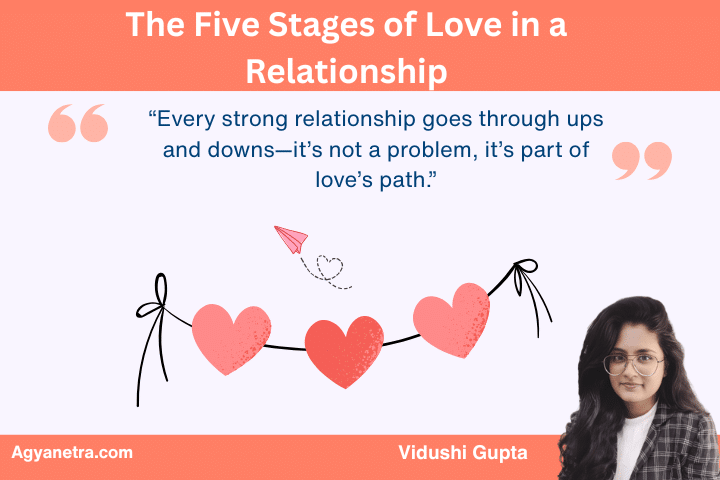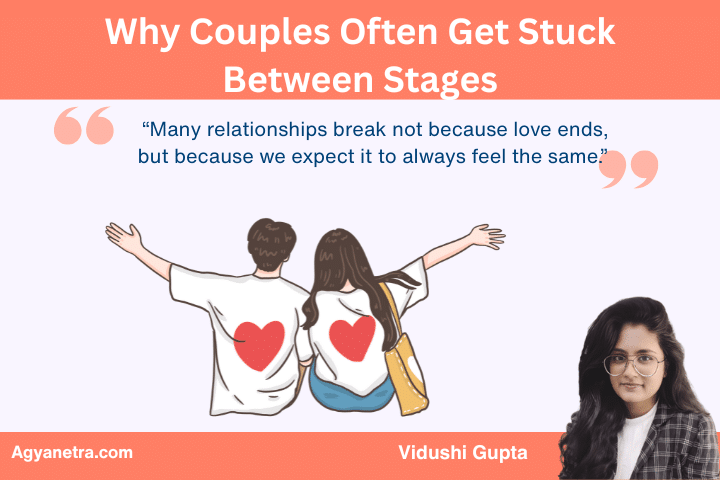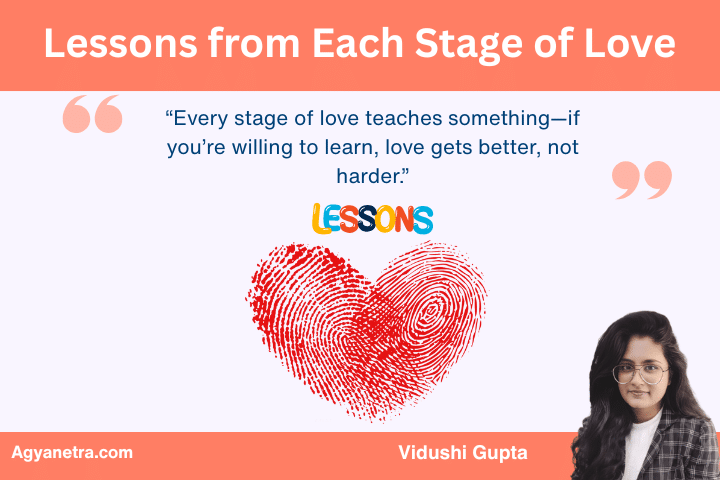Different Stages of Love in a Relationship can feel like a mystery—one moment it’s butterflies, and the next, it’s misunderstandings or calm silence.
Have you ever wondered why love starts off exciting but later feels different? You’re not alone.
Love doesn’t stay the same throughout a relationship—it grows, changes, and sometimes challenges us.
In this article, you’ll explore how love moves through natural emotional stages, what each phase means, and how understanding them can actually make your bond stronger.
Whether you’re at the start of something new or years into a partnership, this guide will give you clear insights to help you connect, grow, and love better.
Keep reading—you may see your own love story reflected in these stages.
In new romantic love, levels of the stress hormone cortisol increase sharply as your body reacts to emotional intensity — sources from Harvard Medical School show this rise in cortisol during the early love phase.
Different Stages of Love in a Relationship: What Each Phase Feels Like
Love is a beautiful journey, but it doesn’t remain the same from beginning to end.
It changes with time, challenges, understanding, and shared experiences.

Whether it’s young love blooming in the early days or mature love holding strong after decades, knowing the different stages of love in a relationship helps us move through each phase with more clarity and care.
Love is not a straight line—it grows, bends, softens, and deepens. As Vidushi Gupta explains, love mirrors our own growth.
When we understand the emotional changes that happen as love evolves, we stop asking if love is “fading” and instead ask, “How are we growing?”
Let’s explore the five main stages of love and how each one shapes the way we feel, act, and connect with our partner.
Why Understanding These Stages Matters
Most couples enter relationships full of excitement. But when things begin to shift, many wonder if they’re falling out of love.
In reality, love simply evolves. The early rush of emotions is only one part of the journey. Lasting love also includes understanding, patience, and shared growth.
Knowing the stages of a relationship helps you:
- Recognize emotional patterns
- Avoid panic when things feel different
- Communicate better with your partner
- Grow together, not apart
Just like seasons—spring, summer, fall, and winter—love changes. And every season serves its own purpose.
The Five Stages of Love in a Relationship
Each stage has its own feeling, rhythm, and challenges. Couples may move through them in order, circle back to some, or stay longer in one phase.

There’s no perfect path—but recognizing these stages helps you navigate them with care.
Stage 1: Attraction and Infatuation
This is the start of everything. It’s the butterflies-in-the-stomach phase when your heart races just thinking about the person.
You’re curious, fascinated, and drawn toward them. This attraction is usually physical, emotional, or both.
In this early stage, brain chemicals like dopamine and norepinephrine make everything feel exciting and positive.
You focus on what’s perfect about the other person, and differences are easily overlooked.
For example, you might fall for someone who loves the same music as you or makes you laugh in a way no one else does. You stay up talking late into the night and want to be around them all the time.
But as Vidushi Gupta reminds us, this stage is just the beginning.
Attraction is nature’s way of pulling two people together, but it’s not enough to keep them together long-term.
What helps in this stage:
- Enjoy the excitement, but don’t rush into big decisions
- Ask thoughtful questions about their values and goals
- Stay connected to your own life and friendships
Stage 2: Romance and Emotional Bonding
This stage deepens the connection built in the first phase. You move beyond physical attraction and start developing emotional intimacy.
You open up about your past, dreams, fears, and future hopes.
This is often called the honeymoon phase. You feel supported, heard, and seen by your partner.
You imagine a life together and may even begin forming routines—date nights, shared plans, or meeting each other’s families.
An example of this might be when you and your partner talk about moving in together or take a trip where everything just feels right. You begin to feel safe in their presence.
Vidushi Gupta calls this the “emotional weaving” phase—where shared moments and vulnerabilities begin to build trust.
But it’s also important to realize that not everything will always be smooth.
What helps in this stage:
- Keep communication honest and kind
- Continue building your friendship alongside romance
- Talk about expectations around love, space, and commitment
Similar reads:
- Difference Between Loving Someone and Being in Love
- What Are the 4 Stages of Emotion Processing
- How Do You Know if a Man Truly Loves You
- Signs of Romantic Obsession and How It Differs from True Love
Stage 3: Reality and Power Struggles
This is the turning point in most relationships. After the initial glow fades, you begin to notice flaws, differences, and habits that can cause friction.
You may argue more or feel disappointed when your partner doesn’t meet all your emotional needs.
It’s normal. This is where real love begins to grow—through effort, understanding, and compromise.
Vidushi Gupta describes this as the “mirror stage,” where love reflects back the things we still need to heal within ourselves.
For instance, you might feel hurt when your partner pulls away during stress, while they may feel overwhelmed by your emotional needs.
These moments can trigger past wounds or personal fears.
What helps in this stage:
- Learn how to handle disagreements without blaming
- Reflect on your own behavior, not just your partner’s
- Practice patience—emotions need space and time
- If needed, talk to a relationship counselor or coach
This is the most challenging stage of love, and sadly, many relationships end here.
But if couples move through this phase with emotional maturity, love becomes stronger than ever.
Stage 4: Stability and Deep Commitment
Once couples navigate their differences and learn how to support each other, they enter a more stable phase. This stage brings a quiet, comforting kind of love.
It may not be as intense as the honeymoon period, but it’s richer in trust and understanding.
Here, you begin to rely on each other in deeper ways—during life changes, career moves, health issues, or family decisions.
There’s emotional safety, and both partners feel accepted as they are.
For example, a couple who has been together for several years may know how to support each other during stress without needing many words.
Their love isn’t about grand gestures but small daily acts of care.
Vidushi Gupta says this phase is where “love becomes a soft place to land.” You’re not trying to impress each other anymore—you’re building a life, day by day.
What helps in this stage:
- Keep showing affection, even in small ways
- Encourage each other’s growth, both individually and as a couple
- Celebrate milestones, even the little ones
Stage 5: Mature Love and Co-Creation
This is the deepest stage of love—a space where couples not only stay together but also create something bigger than themselves.
Mature love is built on mutual respect, shared purpose, and emotional freedom.
At this point, love feels rooted. There’s space for individual dreams, but also a strong commitment to shared goals.
You support each other, not because you need to, but because you want to.
A couple in this phase might raise children together, run a business, or dedicate themselves to a meaningful cause. Even during hard times, they stand as a team.
Vidushi Gupta calls this “conscious love”—when two whole individuals come together not to complete each other, but to grow and serve together.
What helps in this stage:
- Set long-term goals as a team
- Revisit dreams and see how they’ve changed over time
- Keep learning from each other
Why Couples Often Get Stuck Between Stages?
The most common place couples get stuck is between romance and reality.
When the early ease gives way to conflict, some believe love is gone. But this discomfort is part of growing closer, not falling apart.

The key is to talk through disagreements, stay curious about each other’s needs, and avoid shutting down.
It’s okay to seek guidance during this phase—therapy, workshops, or books can all help.
As Vidushi Gupta explains, real love is not about avoiding struggles, but learning how to move through them without losing the bond.
Lessons from Each Stage of Love

Each stage brings something valuable:
- Attraction teaches you to take emotional risks
- Romance shows you the beauty of emotional closeness
- Reality offers the gift of self-awareness and acceptance
- Stability brings peace, reliability, and comfort
- Mature love gives purpose and shared meaning
Instead of chasing the excitement of the first stage forever, couples who grow together begin to appreciate the calm and depth that later stages bring.
Practical Tips for Every Stage of Love
- Be honest but gentle when sharing your feelings
- Learn each other’s love languages
- Practice active listening—don’t just hear, understand
- Laugh often and don’t take things too seriously
- Allow room for individual space and hobbies
- Remember why you chose each other
- Keep showing love through words, touch, and time
These habits keep love alive at every level, whether you’re just starting out or years into the relationship.
Conclusion
The different stages of love in a relationship remind us that love is not a one-time experience—it’s a journey that unfolds in layers.
Each phase, from the thrill of attraction to the calm of mature connection, has its own purpose and power.
When we understand the emotional seasons of love, we stop fearing the changes. Instead, we lean in with awareness, patience, and care.
As Vidushi Gupta shares, the beauty of real love is not in how it begins, but in how it evolves with trust, kindness, and shared growth.
Recognizing the different levels of love in a relationship can help every couple build a foundation that doesn’t just last—but thrives.
FAQs
How long does the honeymoon stage of love last?
The honeymoon stage usually lasts between 6 months to 2 years. During this time, couples feel excitement, closeness, and emotional high. After this phase, love begins to mature into deeper understanding and commitment.
Can couples fall in love again after the reality stage?
Yes, many couples rediscover love after working through the reality stage. By learning better communication, understanding each other’s needs, and supporting growth, love can deepen and become stronger than before.
Is it normal for love to feel different over time?
Absolutely. Love evolves with time. The intense feelings of early love often shift into calm, steady emotional bonding. This is part of a healthy relationship journey, not a sign of fading love.
Which stage of love is the most difficult?
The reality or power struggle stage is often the hardest. This is when differences surface and conflicts begin. But it also offers the most growth if couples stay open, honest, and willing to learn together.
Do all relationships go through the same love stages?
Most long-term relationships go through similar emotional phases, but the timing and experience can vary. Some couples may revisit certain stages more than once, especially during big life changes.
Can a relationship skip any of the love stages?
Some stages may appear shorter or blend together, but most couples experience some form of each. Skipping emotional bonding or conflict stages may lead to deeper issues later on.
Why do couples break up during the reality stage?
Many couples break up during this phase because they expect love to always feel easy. When problems arise, they may feel unprepared. Lack of communication and emotional tools is a common reason relationships end here.

Vidushi Gupta is an accomplished writer and digital marketing expert with contributions to organizations like Miles Educomp and ICAI. She has authored nearly ten novels and worked as a Senior Content Writer and Digital Marketing Specialist at ESS Global and Shabd. Her Quora posts have amassed almost 20 million views, reflecting her belief in the transformative power of the written word.
